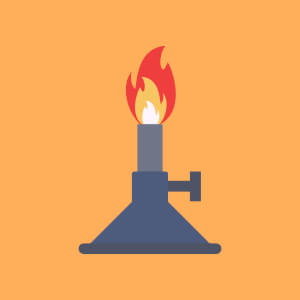



Fire is when a fuel source (such as wood or gas) undergoes a chemical reaction called combustion. During combustion, oxygen atoms steal electrons from the atoms that make up the fuel. This movement of electrons results in the formation of new products like smoke, ash, water (H2O), and carbon dioxide (CO2). Chemists call this "oxidation," when atoms lose electrons during a chemical reaction.
Without both oxygen (O2) and a fuel source, fire can't continue burning. Fire often emits great amounts of heat and light, and while it has many uses for humans, fire can easily spread, becoming extremely dangerous.
During intense wildfires, the heat generated by the flames can cause air to rise rapidly (like a hot air balloon), creating low-pressure areas that pull in cooler air from the surroundings. This can lead to the formation of flammagenitus clouds, which are similar to thunderstorm clouds (cumulonimbus clouds), but are created by the heat of the fire instead of warm and cold air. Pyrocumulus clouds can generate lightning and strong winds, which can cause the wildfire to spread even further.
Cool flames burn at temperatures between 200-600 °C, which is much lower than the typical flames that burn around 1000 °C. They can occur when certain types of fuel are mixed or ignited under certain conditions, such as when a fuel is heated with a catalyst.
Although they don't produce visible light, cool flames are still flames and can be extremely dangerous, especially in industrial settings. If not handled carefully, they can lead to explosions or fires when they come into contact with other materials, including other fuels or chemicals.
Candles are actually pretty clever, so props to the ancient human that invented them. If we tried to light only a piece of string on fire, it would probably burn up pretty quickly—and trying to ignite a plain piece of wax isn't much better. When we light a candle, we light the exposed wick, which gives the wax surrounding it just enough time to melt and turn into a gas—a very flammable gas! This process will keep melting and burning the vaporized wax until it's all gone or someone blows it out.
Oxygen (O2), the same gas we breathe, is a main ingredient in anything involving fire. Remove it, and fires can't burn! Most fire extinguishers work by unleashing a chemical reaction that produces lots of carbon dioxide (CO2), which replaces most of the oxygen around an open flame. Curious to see this in action? Check out the Pourable Fire Extinguisher science experiment.
The color of a fire changes based on how much oxygen (O2) is available: blue for higher oxygen levels and yellow when there is less oxygen. Other substances also affect the color of flames. For example, the metal element sodium (Na), which is found inside the table salt (NaCl) that we eat, can turn flames yellow, and calcium (Ca), another metal element, can turn flames red.